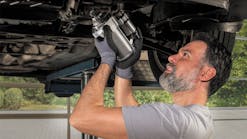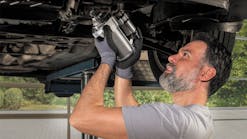Soon after rebuilding a 4L60-E transmission in 2002 and newer Chevy Trailblazers, the vehicle comes back on a tow truck with a sudden no move condition.
Upon disassembly, you discover that the lugs in the pump rotor are sheared off or the rotor itself is shattered.
The cause may be that the 300 mm B-85 torque converter was replaced as part of the job. Some of these converters were rebuilt with a shorter converter drive hub causing the build height to be too short. This will allow the torque converter drive hub to come out of the pump rotor when a hard throttle passing gear maneuver occurs. When the drive hub tries to index itself back into the pump rotor, it is not aligned breaking the drive lugs off. This will, in turn, cause no line pressure/no engagement.
The technician who installs the transmission easily can miss this, as the bell housing is enclosed and the torque converter to flex plate bolts are installed thru a small access hole underneath the structural oil pan.
To ensure a proper height with a replacement converter to avoid this catastrophe, place the converter on a flat surface drive hub down; measure from the flat surface to the top of surface of the mounting pas. The converter build height should be approximately 6 7/16 inches.
Another reason for these rotors to shatter occurs when the vehicle is running for extended periods of time with a code set that initiates high line pressure. The rotor eventually will fail while under the continual demand of pushing high-pressured oil. This rotor also will fail should the pump be able to suck in unwanted air causing it to cavitate. Pump cavitation can be detected by excessive air bubbles on the dipstick of an extremely erratic pressure gauge and usually is caused by low fluid levels, a bad filter neck seal or distorted pump face halves.
Subscribe to Motor Age and receive articles like this every month…absolutely free. Click here


